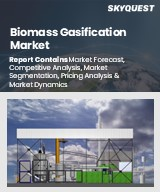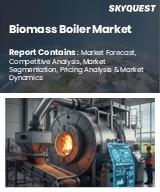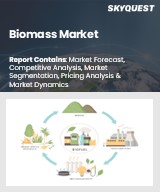
|
시장보고서
상품코드
1500316
세계의 고체 바이오매스 원료 시장(2024-2031년)Global Solid Biomass Feedstock Market 2024-2031 |
||||||
세계 고체 바이오매스 원료 시장은 예측 기간 중(2024-2031년) 복합 연간 성장률(CAGR) 14.6%라는 대폭적인 성장이 전망되고 있습니다. 고체 바이오 매스 원료 시장의 성장은 세계 전력, 열, 바이오연료 및 바이오 메탄 수요 증가로 인한 것입니다. 국제에너지기구(IEA)에 따르면 2024년 2월 현재 향후 5년간의 바이오연료 수요는 380억 리터 확대되어 지난 5년간 30.0% 가까이 증가합니다. 바이오연료의 총 수요는 2028년까지 23.0% 증가한 2,000억 리터입니다.
시장 역학
바이오매스 원료로서 유기 폐기물 이용 증가
재생가능에너지에 대한 수요가 높아짐에 따라 바이오매스 에너지를 만들기 위한 유기폐기물의 이용이 보급되고 있습니다. 지속 가능한 에너지 중 하나는 바이오 매스 에너지이며 나무 쓰레기, 식물, 농업 폐기물과 같은 유기물을 태우는 것으로 생산됩니다. 전미생물공학정보센터에 따르면 2022년 2월 현재 세계 폐기물의 평균 조성의 50.0% 가까이, 하루 300만 톤이 유기물입니다. 이것은 온실가스(GHG)의 주요 발생원이며, 가정 폐기물, 식품 제조 폐기물, 공장 전 폐기물을 포함하며, 나머지는 종이, 플라스틱, 유리, 금속 및 기유형니다. 일부 시설은 폐기물을 토지 살포로 향하고 있지만, 이러한 시설은 유기 폐기물의 26.0%에서 46.0%를 차지하는 것에 지나지 않으며 대부분은 여전히 매립지로 처분되고 있습니다.
고도 변환 기술 채택
바이오매스를 에너지로 변환하기 위한 고도 변환 기술로는 열화학적, 생물학적, 물리학적, 생화학적 프로세스, 하이브리드 기술, 통합 시스템 기술 등이 있습니다. 열화학 기술과 생화학 기술을 포함한 여러 기술의 혼합도 하이브리드 시스템과 복합 시스템을 위해 연구되었습니다. 모든 바이오리파이너리 공정은 원료의 유형과 가용성에 따라 특정 연료를 생산할 수 있습니다. 따라서 이러한 기술을 통합 폐기물 바이오리파이너리 개념 하에서 결합하면 연료, 에너지, 열, 공급 원료 및 가치있는 화학 물질의 형태로 여러 유형의 여러 공급 원료를 처리합니다. 공급을 할 수 있습니다. 하이브리드 구성의 시스템은 유해한 배출이 가장 적고 발전 효율도 가능한 한 높습니다.
시장 세분화
세계 고체 바이오매스 원료 시장을 상세하게 분석한 결과, 다음과 같은 부문 분할이 이루어지고 있습니다.
- 공급원에 따라 시장은 농업 폐기물, 삼림 폐기물, 동물 폐기물, 도시 폐기물로 세분화됩니다.
- 유형별로 시장은 칩, 펠릿, 연탄으로 세분화됩니다.
- 용도별로 시장은 전기, 열, 바이오연료, 바이오 메탄으로 세분화됩니다.
- 최종 사용자를 기반으로 시장은 주택, 상업, 산업 및 유틸리티로 세분화됩니다.
농업 폐기물이 최대 부문이 될 전망
공급원에 의하면, 세계 고체 바이오매스 원료 시장은 농업 폐기물, 삼림 폐기물, 동물 폐기물, 도시 폐기물로 세분화됩니다. 이 중 농업 폐기물 하위 부문이 시장의 최대 점유율을 차지할 것으로 예상됩니다. 이 부문의 성장을 뒷받침하는 주요 요인으로는 풍부하게 이용가능하고 비용 효율적이기 때문에 농업 폐기물에 대한 수요가 높아지고 있습니다. National Center for Biotechnology Information에 따르면, 2022년 10월 현재, 바이오 에탄올은 사탕수수 비바가스, 달콤한 소르감바가스, 벼 짚, 보리 밀짚, 밀짚, 소르감 밀짚, 옥수수 줄기, 카사바 껍질, 사탕무, 목재 등 같은 다양한 농업 폐기물과 작물 잔류물에서 생산됩니다. 이 원료는 비 식용이며 비용 효율적이며 합리적인 저렴한 비용으로 쉽게 얻을 수 있습니다. 바이오연료 생산의 바이오에탄올 점유율은 생산방법의 개선, 현지에서 쉽게 입수할 수 있는 원료의 사용, 다양한 용도에서의 지속적인 바이오에탄올 수요에 의해 약 65.0%에 달했습니다.
바이오메탄 하위 부문이 큰 시장 점유율을 차지
고체 바이오매스 원료 시장은 용도별로 전기, 열, 바이오연료, 바이오메탄으로 세분화됩니다. 이 중 바이오메탄이 상당한 점유율을 차지할 것으로 예상됩니다. 바이오메탄 생산을 위한 혐기성 소화용 휴대용 패브리케이터 제조의 기술 진보는 정확하게 원료의 유형과 생산 경로에 의존합니다. 유럽바이오가스협회(EBA)가 2022년 7월 발표한 '바이오메탄 생성 가능성-2030년과 2050년 혐기성 소화'에 따르면 2030년 혐기성 소화 가능성은 41.8bcm로 추정 그 중 38.1bcm는 EU-27입니다. 2050년의 잠재량은 98bcm로 증가하여 56bcm 증가합니다. 2030년과 2050년 모두 상위 5개국은 프랑스, 독일, 이탈리아, 스페인, 폴란드에서 일관되다. 2030년 주요 원료는 가축분뇨(32.0%), 농업잔사(24.0%), 연작(21.0%)입니다. 이와는 대조적으로, 2050년에는 연작이 47.0%를 차지하고, 분뇨(19.0%), 농업 잔류물(17.0%)이 크게 기여합니다. 산업 폐수는 2030년과 2050년 모두 잠재량의 10.0% 이상에 기여하고 있습니다.
지역별 전망
세계 고체 바이오매스 원료 시장은 북미(미국, 캐나다), 유럽(영국, 이탈리아, 스페인, 독일, 프랑스, 기타 유럽), 아시아태평양(인도, 중국, 일본, 한국, 기타 아시아태평양), 세계 기타 지역(중동 및 아프리카, 중남미)을 포함한 지역별로 더 구분됩니다.
아시아태평양에서 고체 바이오매스 원료 채용 증가
- 이 지역의 성장은 인도, 중국, 일본 등 신흥국의 전력, 열, 바이오연료, 바이오메탄에 대한 수요 증가가 고체 바이오매스 원료 시장의 성장을 견인하고 있기 때문입니다.
- 국제에너지기구(IEA)에 따르면 2024년 2월 인도 정부는 이미 2030년까지 5.0%의 바이오디젤 목표를 설정했으며, 이는 연간 약 45억 리터의 바이오디젤을 필요로 합니다. 사탕수수 이외의 원료를 다양화하기 위해 인도에서는 옥수수를 원료로 하는 에탄올에 별도 가격을 설정하고, 면화 줄기, 밀짚, 벼 짚, 바가스, 대나무 등의 농업 잔류물로부터 생산되는 에탄올을 포함하고 있습니다.
북미가 주요 시장 점유율을 차지
전 지역에서 북미가 큰 점유율을 차지하고 있는 이유는 유명한 기업과 고체 바이오매스 원료 공급업체가 다수 존재하기 때문입니다. 이 지역에서 고체 바이오 매스 원료의 성장을 가속화하는 요인 중 하나는 다양한 국가에서 바이오연료 수요 증가를 포함합니다. 미국 에너지 정보국에 따르면 2022년 바이오매스는 미국 에너지 소비의 5.0%, 약 4,930조 영열량 단위(TBtu)를 차지합니다. 2022년 바이오매스 에너지 총소비량에서 차지하는 바이오매스의 유형, 양, 비율은 바이오연료-2,419TBtu-49.0%, 목재,나무쓰레기-1,984TBtu-43.0%, 도시고형폐기물, 가축분뇨, 하수-411TBtu -8.0%입니다. 산업 부문은 미국에서 바이오 매스의 가장 큰 에너지 소비자입니다. 2022년 미국의 바이오매스 에너지 총 사용량에서 차지하는 소비 부문 비율(TBtu)은 산업용 2,266TBtu-46.0%, 수송용 1,565TBtu-32.0%, 주택용 539TBtu-11.0%, 전력용 413TBtu- 8.0%, 상업용 147TBtu-3.0%입니다.
세계 고체 바이오매스 원료 시장에 진입하는 주요 기업으로는 Chevron Corp., Drax Group plc, Enviva Inc., RWE AG, Siemens AG 등이 있습니다. 시장 경쟁력을 유지하기 위해 시장 기업은 제휴, 합병, 인수 등의 전략을 적용하여 사업 확대 및 제품 개발에 점점 힘을 쏟고 있습니다.
목차
제1장 보고서 개요
- 업계의 현황 분석과 성장 잠재력의 전망
- 조사 방법과 도구
- 시장 분석
- 부문별
- 지역별
제2장 시장 개요와 인사이트
- 조사 범위
- 애널리스트의 통찰과 현재 시장 동향
- 주요 업계 동향
- 추천 사항
- 결론
제3장 경쟁 구도
- 주요 기업 분석
- Chevron Corp.
- 개요
- 재무 분석
- SWOT 분석
- 최근 동향
- Siemens AG
- 기업 개요
- 재무 분석
- SWOT 분석
- 최근 동향
- RWE AG
- 개요
- 재무 분석
- SWOT 분석
- 최근 동향
- 주요 전략 분석
제4장 시장 세분화
- 고체 바이오매스 원료 시장 : 공급원별
- 농업 폐기물
- 삼림폐기물
- 동물 폐기물
- 도시폐기물
- 고형 바이오 매스 원료 시장 : 유형별
- 칩
- 펠렛
- 연탄
- 고체 바이오매스 원료 시장 : 용도별
- 전기
- 열
- 바이오연료
- 바이오메탄
- 고체 바이오매스 원료 시장 : 최종 사용자별
- 주택?상업
- 산업
- 유틸리티
제5장 지역 분석
- 북미
- 미국
- 캐나다
- 유럽
- 영국
- 독일
- 이탈리아
- 스페인
- 프랑스
- 기타 유럽
- 아시아태평양
- 중국
- 인도
- 일본
- 한국
- 기타 아시아태평양
- 세계 기타 지역
- 라틴아메리카
- 중동 및 아프리카
제6장 기업 프로파일
- Arbaflame AS
- Bioenergy International
- Biomass Secure Power Inc.
- Drax Group plc
- Ecostrat Inc.
- Enerkem Inc.
- Enviva Inc.
- Fram Renewable Fuels, LLC
- Fulcrum BioEnergy
- Georgia Biomass, LLC
- German Pellets GmbH
- Goteborg Energi
- Green Circle Inc.
- Hawkins Wright Ltd.
- Rentech, Inc.
- Stora Enso Oyj
- Targray Technology International Inc.
- Viridis Energy Inc.
Global Solid Biomass Feedstock Market Size, Share & Trends Analysis Report by Source (Agriculture Waste, Forest Waste, Animal Waste, and Municipal Waste) by Type (Chips, Pellets, and Briquettes) by Application (Electricity, Heat, Biofuels, and Biomethane) and by End-Users (Residential & Commercial, Industrial and Utilities) Forecast Period (2024-2031)
Global solid biomass feedstock market is anticipated to grow at a significant CAGR of 14.6% during the forecast period (2024-2031). The growth of the solid biomass feedstock market is attributed to the increasing demand for electricity, heat, biofuels, and biomethane globally. According to the International Energy Agency (IEA), in February 2024, over the next five years biofuel demand is set to expand by 38 billion liters, a nearly 30.0% increase from the last five-year period. Total biofuel demand rises 23.0% to 200 billion liters by 2028.
Market Dynamics
Increasing Utilizing Of Organic Waste as Biomass Feedstock
The use of organic waste to make biomass energy is getting more popular as the demand for renewable energy rises. One form of sustainable energy is biomass energy, which is produced through burning organic materials like wood chips, plant matter, and agricultural waste. According to the National Center for Biotechnology Information, in February 2022, nearly 50.0% of the average composition of global waste, 3 million tons per day, is organic material. This accounts for the main source of greenhouse gases (GHG), and it includes household, food manufacturing, and pre-factory wastes, the rest being paper, plastic, glass, metal, and others. Although several facilities direct their waste toward land spreading, these facilities only represent between 26.0% and 46.0% of the organic waste and most of it is still disposed of in landfills.
Adoption of Advanced Conversion Technologies
Advanced conversion technology for converting biomass into energy, such as thermochemical, biological, physical, and biochemical processes, as well as hybrid and integrated systems technologies. Blends of several technologies, such as thermochemical and biochemical technologies, are also being researched for hybrid or combination systems. All biorefinery processes can produce a specific fuel, though, depending on the type and availability of the feedstock. Therefore, heterogeneous and multiple feedstocks might be treated to provide several supplies in the form of fuel, energy, heat, feedstock, and valuable chemicals if these techniques were combined under the concept of an integrated waste bio-refinery. Systems with hybrid configurations produce the least amount of harmful emissions and the highest possible electrical generation efficiency.
Market Segmentation
Our in-depth analysis of the global solid biomass feedstock market includes the following segments-
- Based on source, the market is sub-segmented into agriculture waste, forest waste, animal waste, and municipal waste.
- Based on type, the market is sub-segmented into chips, pellets, and briquettes.
- Based on application, the market is sub-segmented into electricity, heat, biofuels, and biomethane.
- Based on end-users, the market is sub-segmented into residential & commercial, industrial, and utilities.
Agriculture Waste is Projected to Emerge as the Largest Segment
Based on the source, the global solid biomass feedstock market is sub-segmented into agriculture waste, forest waste, animal waste, and municipal waste. Among these agriculture waste sub-segment is expected to hold the largest share of the market. The primary factors supporting the segment's growth include the growing demand for agricultural waste owing to its availability in abundance and cost-effectiveness. According to the National Center for Biotechnology Information, in October 2022, currently, bioethanol was produced from various agricultural wastes and crop residues such as sugarcane bagasse, sweet sorghum bagasse, rice straw, barley straw, wheat straw, sorghum straw, corn stover, cassava peels, sugar beet, wood, and other. These materials are nonedible, cost-effective, and readily available at a reasonably low cost. The share of bioethanol in biofuel production has reached about 65.0% owing to improved production methods, the use of locally and readily available feedstocks, and the continuous demand for bioethanol for various applications.
Biomethane Sub-segment to Hold a Considerable Market Share
Based on the application, the global solid biomass feedstock market is sub-segmented into electricity, heat, biofuels, and biomethane. Among these, the biomethane sub-segment is expected to hold a considerable share of the market. The technological advancements in the manufacturing of a portable fabricator for anaerobic digestion for biomethane production precisely depend on the type of feedstock and the production pathway. According to the European Biogas Association (EBA), in July 2022, Biomethane potentials - Anaerobic digestion in 2030 and 2050, a potential of 41.8 bcm is estimated for anaerobic digestion in 2030, of which 38.1 bcm relates to the EU-27. The potential increases to 98 bcm in 2050, an increase of 56 bcm. The top 5 countries in both 2030 and 2050 consistently include France, Germany, Italy, Spain and Poland. Key feedstocks in 2030 are animal manure (32.0%), agricultural residues (24.0%), and sequential cropping (21.0%). This contrasts with 2050 in which sequential cropping dominates (47.0%), with again a significant contribution from manure (19.0%), and agricultural residues (17.0%). Industrial wastewater contributes over 10.0% of the potential in both 2030 and 2050.
Regional Outlook
The global solid biomass feedstock market is further segmented based on geography including North America (the US, and Canada), Europe (UK, Italy, Spain, Germany, France, and the Rest of Europe), Asia-Pacific (India, China, Japan, South Korea, and Rest of Asia-Pacific), and the Rest of the World (the Middle East & Africa, and Latin America).
Increasing Solid Biomass Feedstock Adoption in Asia-Pacific
- The regional growth is attributed to the increasing demand for electricity, heat, biofuels, and biomethane in emerging countries like India, China, and Japan driving the growth of the solid biomass feedstock market.
- According to the International Energy Agency (IEA), in February 2024, the government of India has already established a 5.0% biodiesel target by 2030, which would require almost 4.5 billion liters of biodiesel per year. To diversify feedstocks beyond sugar cane, India provides separate pricing for maize-based ethanol and includes ethanol produced from agricultural residues such as cotton stalks, wheat straw, rice straw, bagasse, and bamboo.
North America Holds Major Market Share
Among all the regions, North America holds a significant share owing to numerous prominent companies and solid biomass feedstock providers. The growth is attributed to the increasing demand for biofuels across various countries are few of the factors accelerating the growth of solid biomass feedstock in the region. According to the US Energy Information Administration, in 2022, biomass accounted for 5.0% of US energy consumption, or about 4,930 trillion British thermal units (TBtu) in 2022. The types, amounts, and percentage shares of total biomass energy consumption in 2022 were biofuels-2,419 TBtu-49.0%, Wood and wood waste-1,984 TBtu-43.0%, municipal solid waste, animal manure, and sewage-411 TBtu-8.0%. The industrial sector is the largest consumer of biomass for energy in the US. The amounts in TBtu and percentage shares of total US biomass energy use by the consuming sector in 2022 were industrial-2,266 TBtu-46.0%, transportation-1,565 TBtu-32.0%, residential-539 TBtu-11.0%, electric power-413 TBtu-8.0% and commercial-147 TBtu-3.0%
The major companies serving the global solid biomass feedstock market include Chevron Corp., Drax Group plc, Enviva Inc., RWE AG, and Siemens AG, among others. The market players are increasingly focusing on business expansion and product development by applying strategies such as collaborations, mergers, and acquisitions to stay competitive in the market. For instance, in February 2023, Nippon Paper Industries Co., Ltd., Sumitomo Corp., and Green Earth Institute Co., Ltd. collaborated to begin trilateral consideration of the first commercial production of cellulosic bioethanol from woody biomass in Japan and its development into bio-chemical products.
Recent Development
- In September 2021, SCA and St1 entered a joint venture to produce and develop liquid biofuels. SCA will supply tall oil to the joint venture and invest approximately SEK 60.0 million ($6.9 million) in the company. The new biorefinery is under construction on the St1 refinery site in Gothenburg and will have a total capacity of 200,000 tons of liquid biofuels. It is designed to optimize the production of renewable HVO diesel and bio-jet fuel and to use tall oil-based feedstock. The biorefinery will also be capable of using a wide range of other feedstocks.
Table of Contents
1. Report Summary
- Current Industry Analysis and Growth Potential Outlook
- 1.1. Research Methods and Tools
- 1.2. Market Breakdown
- 1.2.1. By Segments
- 1.2.2. By Region
2. Market Overview and Insights
- 2.1. Scope of the Report
- 2.2. Analyst Insight & Current Market Trends
- 2.2.1. Key Industry Trends
- 2.2.2. Recommendations
- 2.2.3. Conclusion
3. Competitive Landscape
- 3.1. Key Company Analysis
- 3.2. Chevron Corp.
- 3.2.1. Overview
- 3.2.2. Financial Analysis
- 3.2.3. SWOT Analysis
- 3.2.4. Recent Developments
- 3.3. Siemens AG
- 3.3.1. Overview
- 3.3.2. Financial Analysis
- 3.3.3. SWOT Analysis
- 3.3.4. Recent Developments
- 3.4. RWE AG
- 3.4.1. Overview
- 3.4.2. Financial Analysis
- 3.4.3. SWOT Analysis
- 3.4.4. Recent Developments
- 3.5. Key Strategy Analysis
4. Market Segmentation
- 4.1. Global Solid Biomass Feedstock Market by Source
- 4.1.1. Agriculture Waste
- 4.1.2. Forest Waste
- 4.1.3. Animal Waste
- 4.1.4. Municipal Waste
- 4.2. Global Solid Biomass Feedstock Market by Type
- 4.2.1. Chips
- 4.2.2. Pellets
- 4.2.3. Briquettes
- 4.3. Global Solid Biomass Feedstock Market by Application
- 4.3.1. Electricity
- 4.3.2. Heat
- 4.3.3. Biofuels
- 4.3.4. Biomethane
- 4.4. Global Solid Biomass Feedstock Market by End-Users
- 4.4.1. Residential & Commercial
- 4.4.2. Industrial
- 4.4.3. Utilities
5. Regional Analysis
- 5.1. North America
- 5.1.1. United States
- 5.1.2. Canada
- 5.2. Europe
- 5.2.1. UK
- 5.2.2. Germany
- 5.2.3. Italy
- 5.2.4. Spain
- 5.2.5. France
- 5.2.6. Rest of Europe
- 5.3. Asia-Pacific
- 5.3.1. China
- 5.3.2. India
- 5.3.3. Japan
- 5.3.4. South Korea
- 5.3.5. Rest of Asia-Pacific
- 5.4. Rest of the World
- 5.4.1. Latin America
- 5.4.2. Middle East & Africa
6. Company Profiles
- 6.1. Arbaflame AS
- 6.2. Bioenergy International
- 6.3. Biomass Secure Power Inc.
- 6.4. Drax Group plc
- 6.5. Ecostrat Inc.
- 6.6. Enerkem Inc.
- 6.7. Enviva Inc.
- 6.8. Fram Renewable Fuels, LLC
- 6.9. Fulcrum BioEnergy
- 6.10. Georgia Biomass, LLC
- 6.11. German Pellets GmbH
- 6.12. Goteborg Energi
- 6.13. Green Circle Inc.
- 6.14. Hawkins Wright Ltd.
- 6.15. Rentech, Inc.
- 6.16. Stora Enso Oyj
- 6.17. Targray Technology International Inc.
- 6.18. Viridis Energy Inc.




















